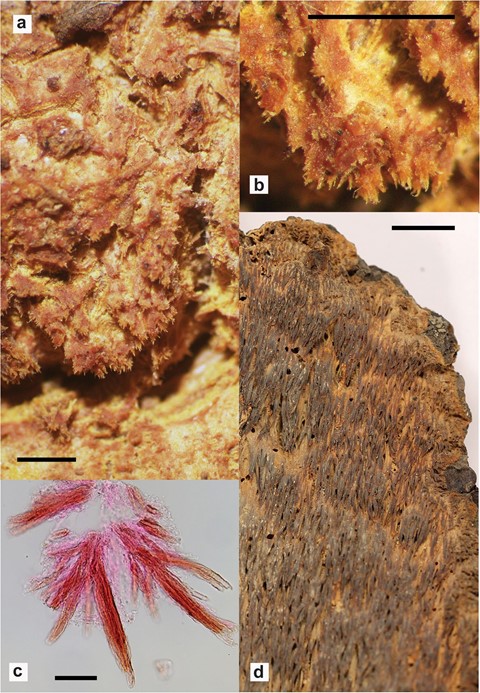Noblesia crocea (Schwein.) Nakasone, comb. nov. Figs. 4 a–c.
MycoBank number: MB 839628; Index Fungorum number: IF 839628; Facesoffungi number: FoF;
≡ Sistotrema croceum Schwein., Schriften der Naturforschenden Gesellschaft Leipzig 1: 102. 1822. [basionym MycoBank# 202956].
≡ Hydnum croceum (Schwein.) Fr., Elenchus Fungorum (Greifswald) 1: 137. 1828. [MycoBank# 232212].
≡ Hericium croceum (Schwein.) Banker, Memoirs Torrey Botanical Club 12(2): 121. 1906. [MycoBank# 439922].
≡ Odontia crocea (Schwein.) Lloyd, Mycological Writings 4, Letter 53, p. 11. 1914. [MycoBank# 356899].
≡ Sarcodontia crocea (Schwein.) Kotl., Česká Mykologie 7(3): 117. 1953. [MycoBank# 305493].
= Phlebia hydnoidea Schwein., Transactions American Philosophical Society 4(2): 165. 1832. [MycoBank# 207657].
≡ Gloeoradulum hydnoideum (Schwein.) Lloyd, Mycological Writings 5. The genus Radulum p. 9. 1917. [Myco- Bank# 439895].
≡ Radulum hydnoideum (Schwein.) Lloyd, Mycological Writings. The genus Radulum 5: 9. 1917. [MycoBank# 440399]. nomen illegit., non R. hydnoideum (Pers.) P. Karsten 1882. [MycoBank# 440398].
≡ Merulius hydnoideus (Schwein.) Zmitr., Folia Cryptogamica Petropolitana 6: 101. 2018. [MycoBank# 827513].
= Odontia lateritia Berk. & M.A. Curtis, Grevillea 1(10): 147. 1873. [MycoBank# 232263].
Ecology and distribution. Saprobic on hardwood, especially Castanea dentata, occasionally on Quercus and Pinus. Reported throughout eastern U.S.A., as far west as Wisconsin.
Type specimens examined. U.S.A. ALABAMA: on Quercus deject., Peter, Curtis 6084 (holotype of O. lateritia K(M) 255185). PENNSYLVANIA: Bethlehem, on rotten trunk, Schweinitz (holotype of P. hydnoidea PH 00064989; isotypes PH 00064988, BPI-Michener Collection).
Other specimens examined. U.S.A. GEORGIA: Rabun County, Chattahoochee National Forest, Warwoman Dell, on Castanea dentata, 8 Jul 1969, H.H. Burdsall, Jr., 1993 (CFMR). PENNSYLVANIA: Bethlehem, Schweinitz s.n. (PH 00062606, as Hydnum croceum #571).
Descriptions and illustrations. Lloyd (1917, fig. 978, as Radulum hydnoideum), Gilbertson (1965: 857, as O. lateritia), Ginns (1970: 242, as P. hydnoidea), Burdsall (1975: 83, as P. hydnoidea), Nakasone and Burdsall (1995: 345, as P. hydnoidea). Remarks. Widely known in the literature as P. hydnoidea, M. crocea is characterized by teeth or spines composed of reddish-brown fascicles of terminal hyphae encased in mucilaginous material and small, ellipsoid It occurs almost exclusively on American chestnut in east- ern United States. See the discussion below for a summary of the misapplication of the name Sistotrema croceum for Sarcodontia setosa. Sarcodontia setosa is the correct name for the well-known and striking species in Europe with long yellow spines and slightly thick-walled, broadly ellipsoid basidiospores that occurs typically on Malus and Pyrus.
For clarity, a complete nomenclatural history and taxonomic synonyms of N. crocea are presented above. The mistaken identity of Sistotrema croceum may have begun with Banker (1906: 121) who transferred it to Hericium and included Hydnum schiedermayeri Heufl. as a synonym, which in turn is a later synonym of H. setosum Pers. Because S. croceum has priority over H. setosum, Banker’s synonymy was generally accepted. Kotlaba (1953) proposed the combination Sarcodontia crocea, and this name was used widely by most European and North American authors, e.g., Nikolajeva (1961: 176), Eriksson et al. (1981:1275), Ginns and Lefebvre (1993: 138), Legon and Henrici (2005: 267), and Bernicchia and Gorjón (2010: 581). A few authors, however, such as Bourdot and Galzin (1928: 418), Cejp (1928: 61–62), Donk (1931: 152), Miller (1933: 364), Miller and Boyle (1943: 40–41), Jülich and Stalpers (1980: 202), and Breitenbach and Kränzlin (1986: 168) used Persoon’s name, H. setosum, for this taxon. Notably, Donk (1931), Miller (1933), and Miller and Boyle (1943) recognized that Banker’s interpretation of Hericium croceum was synonymous with H. setosum but not Sistotrema croceum. Uniquely, Lloyd’s (1914) concept of S. croceum is that of Hydnophlebia chrysorhiza (Eaton) Parmasto (Miller 1933: 364; Martin and Rogers 1958: 308; Burdsall 1985: 61).
The holotype of S. croceum from North Carolina in Schweinitz’s herbarium is presumably lost or destroyed as reported by Banker (1906: 122) and Lloyd (1914). In 1824, Schweinitz possibly sent material of S. croceum to Fries (Shear and Stevens 1917: 202); the specimen at UPS, F-175321, is accepted as the holotype. Because the holotype cannot be borrowed, photographs of this specimen were sent by Dr. Åsa Kruys and show a basidiome that is similar that of Hydnum croceum #571 (PH00062606) from Bethlehem in Schweinitz’s herbarium. The PH specimen is in fair condition with a degraded hymenium, although the characteristic fasciculate terminal hyphae in the spines are abundant and a few ellipsoid spores, 4 × 2–2.4 μm, were observed. Banker (1912: 278) also examined this specimen and reported that it was conspecific with Phlebia hydnoides [sic], which is a typographical error since he clearly meant Phlebia hydnoidea. A specimen of Hydnum croceum #571 was also examined by Berkeley and Curtis (1856: 217) who commented that it is “A well-marked species.” Berkeley (1873: 147), Cooke (1891: 3), Cooke (1956: 401), Gilbertson (1965: 858), and Ginns (1970) among others proposed that O. lateritia and P. hydnoidea were conspecific. This was confirmed by Burdsall (1975: 285) and Nakasone and Burdsall (1995: 347) who examined isotypes and holotypes of both species, respectively. We confirm that N. lateritia and P. hydnoidea are conspecific with and later synonymys of N. crocea.

Fig. 4 Noblesia crocea. a HHB–10759 dried basidiome. b Close-up of aculei in HHB– 10759. b Fascicles of hyphae in aculei of PH00062606; Hydnum amplissimum. d Isolectotype, Sprague 297, UVMVT302881.Scale bars in a and b = 1 mm, c = 50 μm, d = 10 mm
